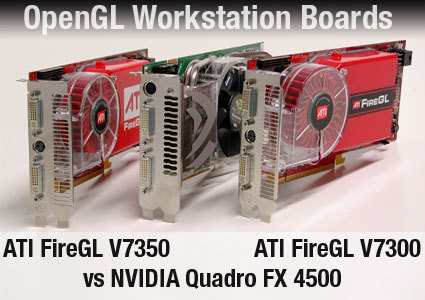OpenGL Workstation Graphics: Now We're Talking High End!
Conclusion
ATi has shown that the FireGL V7350 and V7300 could be real challengers to the dominant Nvidia Quadro FX 4500. However, their potential can only be seen in the synthetic benchmarks from Viewperf 8.1. In the tests with real world applications - 3D Studio Max, Maya and Solidworks - Nvidia was, and still is, ahead of the pack. The ATi developers have also got a few weeks of hard work ahead of them. It is not enough just to optimize the drivers for a synthetic test; the user can only profit from that level of performance if the card runs quickly with real applications. Nvidia has used its advantage in that the product has been on the market longer. And we should also consider that the ATi cards are cheaper than the Nvidia model, and we give price/performance a very high score.
Cards with 1 GB of graphics memory should only be bought by users who will truly exploit this feature. The current benchmarks do not show any increase in performance. More so, in the individual tests, the 1 GB version was often just slightly slower than the 512 MB variant, which can only be explained by the increased effort needed for memory management.
In addition, Nvidia recently showcased the 1 GB variant "FX 4500 X2" that can also access the mature Forceware drivers. We are really looking forward to the Quadro FX 5500 with 1 GB, which should not be confused with the similar-sounding GeForce FX 5500, since they use two completely different chip technologies.
Finally, it should be noted that both manufacturers support both the classic monitor resolutions up to 3840x2400 (9 Megapixels) as well as all the important HDTV formats.
We are still very concerned about the future security of OpenGL products, in conjunction with the upcoming operating system Windows Vista. Microsoft made the political decision to no longer directly support the OpenGL interface - Vista only maps the OpenGL functions using a DirectX emulator, which could mean a considerable loss in performance. Moreover, the range of functions is restricted to OpenGL 1.4, while today's standard is already 2.0, and manufacturer-specific extensions will no longer be taken into account. Even if ATi and Nvidia were to kowtow to the pressure from Microsoft, it is not exactly useful to them unless the developers of professional applications play along.
Update: Statement from NVIDIA
The development of the upcoming Windows Vista is still in progress. Due to public pressure, there might be some positive changes. Read NVIDIA's statement from June 22, 2006: "Microsoft will be fully supporting OpenGL in Windows Vista, both through an internal OpenGL 1.4 fallback driver (worst case scenario), through Windows XP ICDs (though this will disable the compositing desktop), and through vendor-supplied OpenGL ICDs that share the same status as DirectX, and fully support the compositing desktop."
Get Tom's Hardware's best news and in-depth reviews, straight to your inbox.
slide show and Forumz Link
View The OpenGL slide show
-
I just stumbled upon your blog after reading your blog posts wanted to say thanks.i highly appreciate the blogger for doing this effort. http://www.electrocomputerwarehouse.comReply

